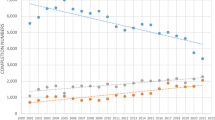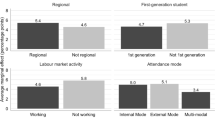Abstract
The objectives of the study were to criticallyexamine the desirability of the catchment areapolicy in the admission process in Nigeria andto analyse the implementation and implicationsof catchment factor as one of the criteria usedin the admission process into NigerianUniversities.
Three federal universities were purposefullysampled for the study. Data were obtained fromthe universities' admission officers,examination and record officers, faculty anddepartmental examination officers. Data werealso collected from the Joint Admissions andMatriculation Board, the National UniversitiesCommission and the Federal Ministry ofEducation.
Data were collected through a preparedchecklist. Two research questions were raisedand two hypotheses formulated. The obtaineddata were analysed by using simple percentageespecially for the trend and comparativeanalysis. The t-test statistic and anova wereused to test the hypotheses, while simplepercentage and ratios were used to compute thewastage rate difference.
The major findings include: that admissionratio into the universities among states wasnot proportional to the size of enrolment atthe terminal grade of the secondary schoollevel in these states which justify affirmative policies such as the one in focusto redress the imbalance; that the universitieshave been implementing faithfully the policyaccording to the laid-down guidelines; that themajor groups in the catchment area of eachuniversity predominate admission, except wherea major group is absent; and that there was asignificant difference in the quality ofperformance of students admitted on merit andthose admitted through catchment area policywhile a no significant difference was found inthe academic performance among studentsadmitted through catchment area, universitydiscretion and educationally disadvantagedstates; and that the wastage rate of those onmerit was lower than those through thecatchment area policy.
Based on the findings, the study suggested thatthe policy should be retained, but finetuned soas to effectively serve as a measure throughwhich the imbalance in university educationcould be minimized and increased access touniversity education by the various groups inthe country would be assured. However, thepaper suggested that the percentage allocatedto this factor be reduced in the light of itsnegative implication on the quality of studentperformance and subsequently the primaryobjective of university education.
Similar content being viewed by others
References
Adeyemi, J.K. (1990). ‘An analysis of the supplemental sources of financing higher education in a developing country: A case of Nigerian universities’, The Educational Planner 1(3/4), 44–53.
Adeyemi, J.K. (1995). ‘The catchment area factors in university admissions in Nigeria’, an unpublished research report.
Aghenta, J.A. (1993). Principles and Practices of Educational Planning: Focus on the Developing Countries. Benin City: NSEP.
Anderson, C.A. (1983). Social Selection in Education and Economic Development. Washington D.C.: World Bank, Educ. Dept.
Azelama, J. (1994). ‘University admission by federal character: Implication for Nigeria political development’, Studies in Education 1(3/4), 1–15.
Babalola, J.B. (1990). ‘Integration of the university manpower production to the work environment in Nigeria’, The Educational Planner 1(3/4), 1–15.
Blaug, M. (1978). ‘Thoughts on the distribution of schooling and the distribution of earnings in developing countries’, Paper prepared for a Seminar at the IIEP, Paris.
Chau, T.N. (1980). ‘Size of school standards and catchment areas’, Intensive Course on Micro-Planning and School Mapping. Ibadan: University of Ibadan, Lecture No. 10.
Federal Republic of Nigeria (1981). National Policy on Education. Lagos: Government Press.
Hallack, J. (1977). Planning the Location of School: An Instrument of Educational Policy. Paris: UNESCO-IIEP.
Ike, V.C. (1982). ‘Nigerian universities and national integration’, in Baike, A. (ed.), Higher Education and Development in the Context of the Nigerian Constitution. Benin City: University of Benin, pp. 140–158.
Joint Admission and Matriculation Board (JAMB), (1978). Guidelines for Admission to First Degree Courses in Nigeria Universities. Lagos: JAMB.
Kosemani, J.M. (1995). ‘Democratic values and university admissions in Nigeria’, Nigerian Journal of Professional Studies in Education 3, 78–83.
Megaforce (1999). ‘Federal government, teachers, students’, Nigerian Tribune, September 6.
National Concord (1994). ‘ABU VC blames catchment areas ... over admission of indigenes’, Friday, June 3rd, Lagos (Newsreport).
National Universities Commission (1996). Digest of Statistics. Abuja: NUC.
Nwideeduh, S.B. (1995). ‘Ethnicity and the Nigerian university system’, Nigerian Journal of Professional Studies in Education 3, 91–97.
Ochuba, V.O. (2000). ‘An analysis of wastage among fresh student in Nigerian universities: A case study of the University of Benin’, Unpublished Ph.D. Thesis, University of Benin.
Ogunsanwo, O.A. (1990). ‘Power in academic: A study of the Nigerian university systems’, African Journal of Educational Management 3(1), 95–102.
Ogunyemi, B. (1994). ‘The myth and reality of literacy for all Nigerians by the year 2000’, Osiele Journal of Educational Studies 1(1), 135–143.
Psacharopolous and Woodhall (1985). Education for Development: An Analysis of Investment Choices. Washington D.C.: IBRD/World Bank.
Salim, A.B. (1999). ‘JAMB: The challenges ahead’, Education Column, The Post Express, November 9.
Suleiman, J. (1998). ‘National ideological guide for national development: A proposal’, Benin Journal of Educational Studies II(1/2), 139–144.
Sunday Tribune (1979). ‘Educational report on JAMB’, March 18.
The Guardian (1999). ‘ASUU strike may end this week, says Obafemi Awolowo University Vice-Chancellor’, News Report, Tuesday, October 26.
UNICEF/FOS (1997). The Progress of Nigerian Children. Occasional Publication, Lagos: UNICEF/Federal Office of Statistics.
Whawo, D.D. (1990). ‘Towards a pragmatic policy on higher education in Nigeria by the year 2000’, The Educational Planner 1(3/4), 104–114.
World Bank (1980). The Education Sector Policy Paper. Washington D.C.
World Bank (1981). World Development Report. New York: OUP.
World Bank (1994). The Dynamics of Education Policy-Making. Washington D.C.: The World Bank.




